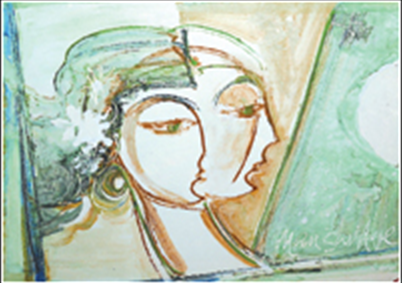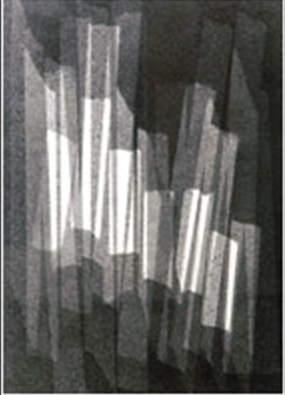Mansur Aye (1941- 2008)
This is a collection of articles archived for the excellence of their content. Readers will be able to edit existing articles and post new articles directly |
Mansur Aye (1941- 2008)
IN MEMORIAM: Mansur Aye (1941- 2008): An artist who followed his muse
Aye was a self taught artist and though he experimented with diverse subjects over the years, he invariably returned to his muse, the ‘Moon Faced’ girl, writes Marjorie Husain
When Mansur Aye passed away on April 12th, he left behind a legacy of art that began in the exciting era of the ’60s when it seemed, anything was possible. Aye was born in Delhi, and made his home in Karachi where he was one of the young artists exploring modern art in the company of Jamil Naqsh, Bashir Mirza, Mansur Rahi, Shahid Sajjad and Laila Shahzada, all of whom adapted the changes of the times to their own individual viewpoints.
Aye was a self taught artist and though he experimented with diverse subjects over the years, he invariably returned to his muse, the ‘Moon Faced’ girl. He was one of the early members of the USIS organised Sketch Club, where students were supplied with art materials. It was a landmark in Karachi in the 1950s, and he proved to be a talented draughtsman.
There were no art schools in the city at the time and Aye attended courses along with his friends Masood Kohari and Jamil Naqsh. He first showed his work in exhibition at the Karachi Arts Council in 1962, in a two-artist exhibition shared with Jamil Naqsh. In those days one discerned a strong cubist influence in his work, fragmented faces outlined in minimal, spontaneous strokes. He had an innate feel for colour, which made his work a visual joy, full of movement and optimism.
In 1963, he was awarded third prize in painting, from the National Art Exhibition held in Rawalpindi, and in 1964, he mounted his first solo exhibition at the Arts Council, Karachi.
Along with his peers, Aye visited Thatta and the rural areas of Sindh and in 1967, showed an interesting collection of paintings depicting the old dwellings and structures of the rural areas. His linear fluency led to a solo exhibition of drawings in the media of charcoal and pen and ink in 1972, and he went on to study the art of animated cartoon films.
Since those early days Aye’s focus and time had been totally devoted to art. He contributed considerably to the field of animated cartoon films, and also explored documentary film making. It was his ambition to document through films prominent artists of his time but, the necessary sponsorship was not forthcoming. As he predicted, many of those artists are now gone and forgotten.
Mansur Aye very much enjoyed change and experimentation in his work. When a printmaking workshop took place in Karachi in the ’90s, he was very much involved and began to make his prints on handmade paper he devised through the family washing machine. He tried the effects of faces outlined in baked clay and set on paper, and he painted musicians, landscape and other subjects but always returned to his muse. The story goes he phoned a friend and stated simply: “She’s back!”
One of Pakistan’s first art collectors, Mr. Sultan Mahmood, was a great admirer of Aye’s work and acquired a large collection of his drawings and paintings. For a time in the late ’90s, Mr. Mahmood ran a gallery near Boat Basin in Karachi to house his vast collection and there Aye showed an outstanding series of work he titled ‘Clifton beach’. With sympathetic insight he depicted the city’s citizens in holiday mood, enjoying the cool breezes with friends and family on the sea-front.
The Indus Gallery was Aye’s favourite venue for exhibitions, and he frequently showed his work there, the last exhibition held in 2006. One was constantly intrigued by the diverse innovations he brought to the interpretation of his muse. His paintings are evidence that he retained his unique touch throughout his life.
One was constantly intrigued by the diverse innovations he brought to the interpretation of his muse
Mansur Aye II
Last chance to see, own ‘moon-faced girls’
By Our Staff Reporter
ISLAMABAD, Aug 28: Gallery 6 opened its doors to the art lovers of the city to a display of the enchanting paintings of moon-faced girls by Mansur Aye who passed away last April.
Mansur Aye’s artistic career of more than 40 years was marked by prolific productions. His first solo exhibition was held in 1964 in Arts Council Karachi and the last in 2007 at Indus Gallery, Karachi.
Over decades, his aesthetic creativity faithfully painted moon-faced girls in different guises and different sizes, and the spontaneous movements of his brush strokes continued to create and reflect their moods.
These were enhanced by the application techniques of the color and simple compositions, often dominated with linear gestural movements. The works were an amalgam of abstraction and expressionism and reflected artist’s love for the female gestures.
The focus on his canvas mainly remained on facial features and hair, with addition of a few ornaments, bird or moon.
He created feelings with minimal details but interesting hues. The effects gave the impression that the works were completed without any interruption in single sitting with absolute control.
Commenting on the works, Dr Arjumand Faisal, the curator of the gallery said that these works were to be enjoyed for their vibrant colors, melting tones, moods and gestures presented with marvelous simplicity rather than searching for conceptual content. This distinctive signature work that he carried on for decades showed his strength of inventiveness and chromatic sensitivity, and also reflected the highs and lows that he may have faced in life.
This display and sale at Gallery 6 will continue till September 15.
“This is probably the last chance for the art collectors in Islamabad and Rawalpindi to pick up the genuine works of the painter before the galleries in Islamabad also are flooded with copied works, as has started happening in Lahore and Karachi,” Dr Arjumand said




